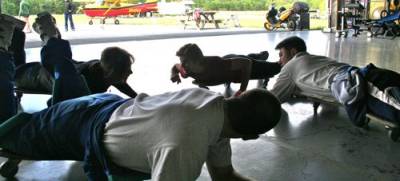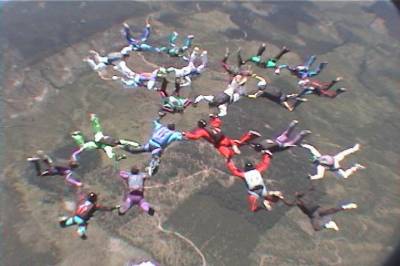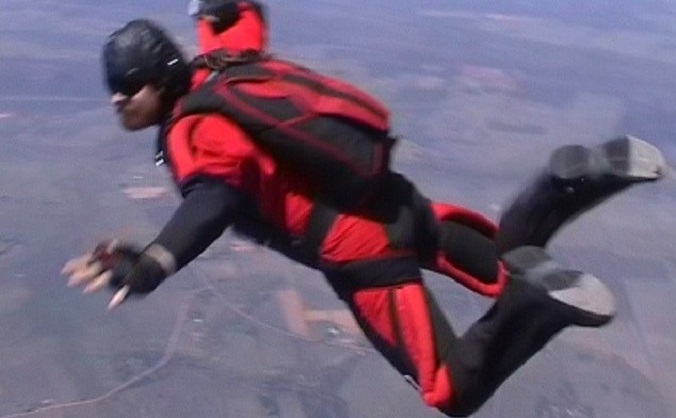In the course of the hundreds of formation skydiving jumps I did and competing at two national championships, I learned a few lessons that I now apply professionally in business communications. For people who's only exposure to skydiving is the movie 'Point Break', it may come as a surprise that it's not like that at all. Don't expect to exit an aircraft and 'naturally' get it right. Skydivers proportionately spend a lot of time preparing for jumps to get them right - to stack the odds in favor of getting a complex 3D maneuver come together and work. Because screwing up has real and immediate consequences, skydivers have developed simple, easy-to-remember best practices that have given the sport a good track record for safety despite the inherent risk. These best practices translate effectively to crisis communications.
Plan the dive and dive the plan
Skydiving teams plan each dive. When you have only 30 seconds to execute a flawless jump, every second counts and every movement the team performs must be synchronised and efficient. Team members have strengths and weaknesses and for every jump, the team plans the jump on the ground to maximize efficiency. They plan how they will climb out of the door of the aircraft at exit altitude, how to pick up grips, how to launch, and how to transition from one formation to the next. And a recovery plan, if things go wrong. Details, details, details.
Similarly, communications at a time of crisis is not the time to begin creating new ideas and procedures or discovering you don't have what you need to successfully manage the communications aspect of an developing issue.
This is particularly true in a media landscape with a 24-hour news cycle or a world in which something can go viral very rapidly. Preparation is key. Communications departments should have a plan in place to ensure that key staff can be reached at any time, that the database of contact information is up to date, and that all of the relevant information about products and services is at their fingertips, even if the power is out.
Communications is a team sport
 Everyone has a role. Some skydivers like to be first out and hanging by their fingertips while waiting for the others to climb out and settle into the exit formation. Some teams designate one of the team to provide an additional warning when it's time to separate and deploy canopies. If one skydiver within a team exits the aircraft too soon, a jump can be unrecoverable.
Everyone has a role. Some skydivers like to be first out and hanging by their fingertips while waiting for the others to climb out and settle into the exit formation. Some teams designate one of the team to provide an additional warning when it's time to separate and deploy canopies. If one skydiver within a team exits the aircraft too soon, a jump can be unrecoverable.
Like the corporate world, at a competition, a simple error can cause a loss. Within an organization, everyone has to row together. Sales, customer service, corporate communications, technical developers - and the boss - should all be working from the same script. This requires a sound sense of the corporate culture, staff having internalized the mission statement, and a willingness to be a team player. The outside world won't care for your office politics; rather, the media or customers getting poor service will use it against you.
Always have a Plan B
 Skydivers plan a recovery strategy if things go wrong during a jump. Many will have an altimeter on their wrist and an audible altimeter in their helmet that signals when it's time to deploy a canopy. They have a reserve canopy in case the main malfunctions. Many have an automatic opening device that will deploy their reserve in the event of unconsciousness.
Skydivers plan a recovery strategy if things go wrong during a jump. Many will have an altimeter on their wrist and an audible altimeter in their helmet that signals when it's time to deploy a canopy. They have a reserve canopy in case the main malfunctions. Many have an automatic opening device that will deploy their reserve in the event of unconsciousness.
By comparison, how prepared is your organization? Have you run through a range of scenarios that are critical to your organization? Have you planned for what to do if something goes wrong? While working in broadcasting as a news Executive Producer, I always had an extra story in the line-up in the event a satellite feed to a live event went down, or, back in the day, the tape machine ate the tape. And it isn't enough to have a Plan B on paper. Can your number two person use the software to issue the media release under pressure or access Hootsuite to post to social media if the number one person is in hospital with appendicitis? Have they been trained on what to do and can they demonstrate what they were shown eight months or a year later?
Practice, practice, practice
Before I got onto the aircraft ahead of every jump, I would physically rehearse what I would do in the event my main canopy malfunctioned. It helped build muscle memory. Similarly, having a Plan B isn't enough unless you test it from time to time. And if things go wrong, make sure that the debrief isn't about playing the blame game. Unless you learn from process errors, best practices can't be developed and best practices should include some of the most likely scenarios of what to do when someone screws up; because somebody will. If surgeons with years of experience and a team can leave instruments inside their patients, someone is going to hit the SEND button on a communications piece under pressure when there should have been a second pair of eyes checking before clicking the mouse. Organizations should hold a crisis communications training scenario annually, with the involvement of key staff, so that problems can be found before they become a problem in their own right.
Check your gear
 The time to discover that a key system is not in place is not when the phone is ringing or a clip about one of your products or services going wrong is attracting millions of views and shares on Youtube. Skydivers have a routine - they check their gear before putting it on; then check it again before entering the aircraft; they check it at 1,000 feet; and they check it before exiting. If anything is wrong at any one of those points, they call off the jump and fix the problem. Organizations have discovered at the wrong times that the video footage that should have been archived has been recorded over or that the backup of the website MySQL database wasn't done and that the new site migration is a disaster. In sectors like finance and regulated industries like biopharma, social media planning must take into account the legal ramifications of what may and may not be shared or tweeted and everyone on those teams must be briefed and trained to prevent crossing the line. Looking back at problems, the throwaway comment that 'hindsight is 20/20' may well be true; however, often one will find that practices were never put in place or standardized to routinize the prevention of problems.
The time to discover that a key system is not in place is not when the phone is ringing or a clip about one of your products or services going wrong is attracting millions of views and shares on Youtube. Skydivers have a routine - they check their gear before putting it on; then check it again before entering the aircraft; they check it at 1,000 feet; and they check it before exiting. If anything is wrong at any one of those points, they call off the jump and fix the problem. Organizations have discovered at the wrong times that the video footage that should have been archived has been recorded over or that the backup of the website MySQL database wasn't done and that the new site migration is a disaster. In sectors like finance and regulated industries like biopharma, social media planning must take into account the legal ramifications of what may and may not be shared or tweeted and everyone on those teams must be briefed and trained to prevent crossing the line. Looking back at problems, the throwaway comment that 'hindsight is 20/20' may well be true; however, often one will find that practices were never put in place or standardized to routinize the prevention of problems.
Reviews are not just another meeting
Formation skydivers regularly use a videographer to record their entire jump. The goal is so that when they are on the ground, the team can review what they did and look for efficiencies and improvements. Did they 'dive the plan'? Building in time for team reviews of projects, events, and processes is an important part of developing a leaner communications process, improving outcomes, and putting in place a forum where team inputs into problem solving can be made accessible and risk free.
If at first you don't succeed...
 The old joke in skydiving is that 'if at first you don't succeed, then skydiving is not for you.' But the fact of the matter is that the lessons learned - often times through deaths - of putting in place processes and checks and balances has transformed the sport into a relatively safe activity. The lessons obtained from this approach, which tames a high-risk activity, provide proven approaches to reducing risk in corporate communications activity, whether they are media relations or managing social media accounts. Integrated Media Strategies uses these approaches in their communications consulting and can help troubleshoot, identify risk areas and help set up best practices to reduce risk and improve communications outcomes. While we are happy to help you after a communications malfunction, we'd prefer to help you land safely. Contact us to see how we can help.
The old joke in skydiving is that 'if at first you don't succeed, then skydiving is not for you.' But the fact of the matter is that the lessons learned - often times through deaths - of putting in place processes and checks and balances has transformed the sport into a relatively safe activity. The lessons obtained from this approach, which tames a high-risk activity, provide proven approaches to reducing risk in corporate communications activity, whether they are media relations or managing social media accounts. Integrated Media Strategies uses these approaches in their communications consulting and can help troubleshoot, identify risk areas and help set up best practices to reduce risk and improve communications outcomes. While we are happy to help you after a communications malfunction, we'd prefer to help you land safely. Contact us to see how we can help.





Subscribe